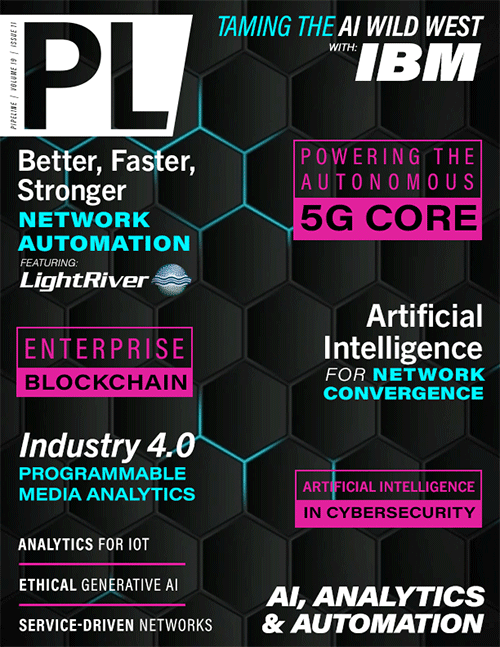Letter from the Editor

Artificial Intelligence (AI) is nothing new. It’s hard to be precise, but I believe Pipeline published its first article on AI for smarter communications in 2016. In the article, we explored how AI was being used by service providers such as AT&T and BT to improve the Customer Experience (CX), by major tech players like HPE, IBM, NVIDIA, and Microsoft, and to potentially create new use cases for IoT, SDN, and NFV. At the time, AI was viewed as a bit of a novelty, with a good measure of skepticism. But those who doubted the potential of AI missed out, and like it or not, AI is here and it’s here to stay.
Pipeline is a perfect AI use case. We have twenty years of industry content, including over 3,000 thought-leadership articles from countless contributors. We receive thousands of press releases each month that get distilled into our daily news coverage, and drink from a deluge of social and other media channels on a daily basis. In 2008, we built our own digital publishing platform to automate the production and distribution of content. And right now, we are evaluating the addition of generative AI and Robotics Process Automation (RPA) for automatic end-to-end content creation. Right now.
Lately, it seems like I get a marketing email from Pegasystems every day extolling how they can help us become an “autonomous enterprise” with AI. (Yet, I can’t get them to reply to any of the numerous inquiries I’ve submitted. Somewhat ironic. Call me!) Add to that the LinkedIn messages I receive each day professing how AI can improve our sales and marketing. AI pops up on virtually every conference call and shareholder meeting—from the companies mentioned above to restaurant chains and apparel companies. It seems like everyone is jumping on the AI bandwagon, and it’s creating a lot of noise. But, there is a beautiful bass line beneath the cacophony.
I see quite a bit of chatter surrounding the “reality of AI,” and I’ve had some good debates over the years. Even way back in 2016, there were real-world AI use cases. And today I must look no further than Pipeline’s 2023 Innovation Awards to see a plethora of tangible AI applications. This year, the AI category was one of the most hotly contested categories with real AI innovations. Submissions from Subex for fraud management, Intraway for the identification of network faults for service orchestration, Promptlink Communications for pinpointing the source of network noise, and ETIYA for creating and modeling network digital twins for multiple test scenarios. And that’s just to name a few. AI also permeated virtually every other category this year. Whittling them down to a select few Finalists wasn’t easy, and it’s now up to 30 service provider and industry analyst judges who serve on our Esteemed Judging Panel to pick the most innovative from the mix.
But with the rise of AI, the risks are also mounting. With so many companies jumping on the AI bandwagon, just navigating the technical landscape has become a challenge to say the least. And the battlefield is no exception. AI has been used for lethal combat for years. Combining lethal AI with facial-recognition technology and key provisions of legislation (such as the Patriot Act, which provides the U.S. government with the authority to conduct drone strikes on its own citizens on its own soil), and we may have a serious problem on our hands. But aside from an actual Terminator scenario, AI is already being harnessed to conduct everything from cyberattacks to phishing attempts—and make them more destructive.
And while sophisticated automation technologies like AI are being used to increase productivity, gain efficiency, and improve customer experiences, the rush to adoption may eclipse relatively important things—like ethics and biased outcomes, too. Not to mention that I can’t even get Skype to work properly on a daily basis. What happens when the entire network or power grid is fully dependent on autonomous technology? These are just some of the reasons that make this edition of Pipeline so important.
In this issue of Pipeline, we dive into the world of AI, automation, and analytics. In a special Spotlight Article, Taming the AI Wild West, I provide insights from a discussion with Madison Gooch at IBM about real-world generative AI use cases, and the launch of watsonx. Radisys discusses how AI and 5G are being used to unlock value with programmable media analytics for self-driving cars and Industry 4.0. Chainstack comments on how to harness the value of enterprise data using blockchain. Oracle discusses how 5G, data center, and cloud trends are driving the demand for a fully autonomous network core. oneM2M looks at AI and ESTI standards for streamlining IoT device management. CommScope shines a light on how enterprises are using AI to automatically identify and resolve IT network issues. LightRiver illustrates how middleware can accelerate network automation and innovation. Ribbon Communications delves into how APIs can be used to create dynamic, software-defined, and service-driven networks. Pipeline’s Dr. Mark Cummings explores how ethical AI can be used to thwart generative AI attacks. Orchestra Group shows us how AI is being leveraged by both bad actors and cybersecurity professionals for attacks and defense. All this, plus the latest enterprise and technology news, and more.
We hope you enjoy this and every issue of Pipeline.
Scott St. John
Managing Editor
Pipeline



















